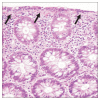Prevalence, Pathogenesis, Diagnosis, and Management of Microscopic Colitis
- PMID: 28669150
- PMCID: PMC5945253
- DOI: 10.5009/gnl17061
Prevalence, Pathogenesis, Diagnosis, and Management of Microscopic Colitis
Abstract
Microscopic colitis (MC), which is comprised of lymphocytic colitis and collagenous colitis, is a clinicopathological diagnosis that is commonly encountered in clinical practice during the evaluation and management of chronic diarrhea. With an incidence approaching the incidence of inflammatory bowel disease, physician awareness is necessary, as diagnostic delays result in a poor quality of life and increased health care costs. The physician faces multiple challenges in the diagnosis and management of MC, as these patients frequently relapse after successful treatment. This review article outlines the risk factors associated with MC, the clinical presentation, diagnosis and histologic findings, as well as a proposed treatment algorithm. Prospective studies are required to better understand the natural history and to develop validated histologic endpoints that may be used as end points in future clinical trials and serve to guide patient management.
Keywords: Colitis, collagenous; Colitis, lymphocytic; Colitis, microscopic.
Conflict of interest statement
No potential conflict of interest relevant to this article was reported.
Figures



References
Publication types
MeSH terms
LinkOut - more resources
Full Text Sources
Other Literature Sources

